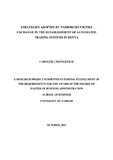| dc.description.abstract | This study was carried out to examine the strategies adopted by Nairobi Securities Exchange
(NSE) in establishment of automated trading systems (ATS). The study was based on the
rationale that adoption of automated trading systems does not only revolve around the benefits
associated with the systems , but also the extent to which the organization is able to integrate the
other factors such as human resources to the process of adoption. As such, the study therefore
sought to answer the question of the extent to which strategies used to adopt automated trading
systems had affected trading performance at NSE. This was in hope that the study would benefit
the NSE management on addressing any challenges associated with the adoption of automated
trading systems, and contribute the existing knowledge on technological research. The study
used a descriptive research design. The study population was composed of top, middle and lower
level of managers at NSE who were purposively selected to participate in the study. Both
secondary and primary data were used in the study. Secondary data provided information of
performance of NSE for different economic sectors in terms of the amount of shares traded
before and after the introduction of automated trading systems. Primary data provided
information on manager’s view on the performance of trading at NSE since and strategies used
in the adoption of automated trading systems. Both quantitative and qualitative techniques were
used to analyse data and draw inferences from the study finding. A multiple regression model
was used to establish whether there was any significant relationship between adoption strategies
and trading performance. Test of significance was done at 95% confidence level. The study
findings indicate a large discrepancy in the traded shares before and after the introduction of
automated trading systems. A positive relationship was found between strategies used in the
adoption of ATS and trading performance. Use of strategies such as staff training, practical
demonstration, capacity building and continuous improvement would increase trading
performance by coefficients of 0.213, 0.920, 0.69 and 0.65 respectively. The study established
that there would be a 56.2% change in trading performance as a result of strategies used in the
adoption of automated trading systems. The study recommended that NSE management
continuously adopt new technology to enhance efficiency in the performance of automated
trading systems, integrate different strategies so as to ensure effective adoption of new or
efficient use of the existing technology and increase level of stringency as far as monitoring the
trading practice is concerned. The orgranziation could do so by increasing penalty or sunctions
associated with malpractices. Further study should be carried out on the factors affecting the
efficiency of automated trading systems at NSE, examine the relationship between employee
training and their performance in the use of automated trading systems and the challenges
affecting use of automated trading systems in the quest to readress the proffessional
malpractices that arise from the use of Automated trading systems. | en_US |

